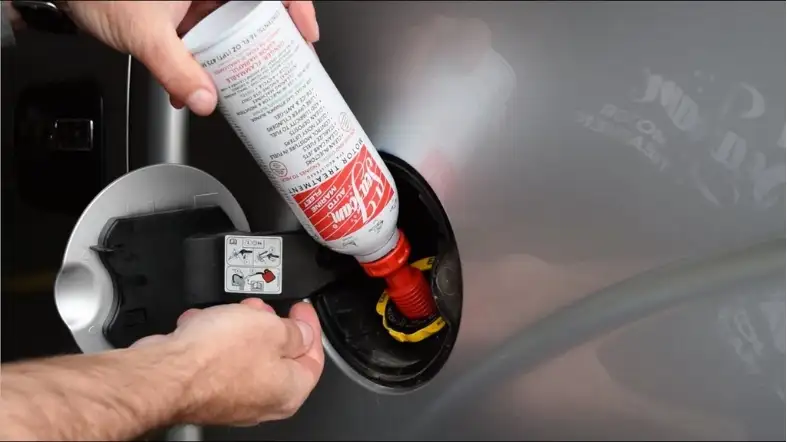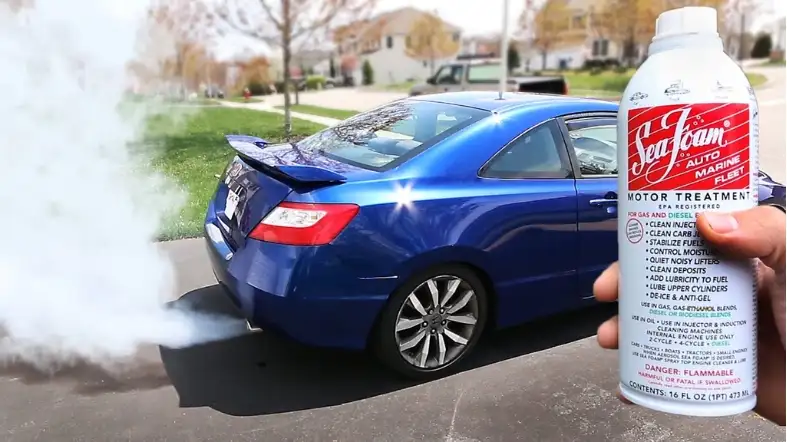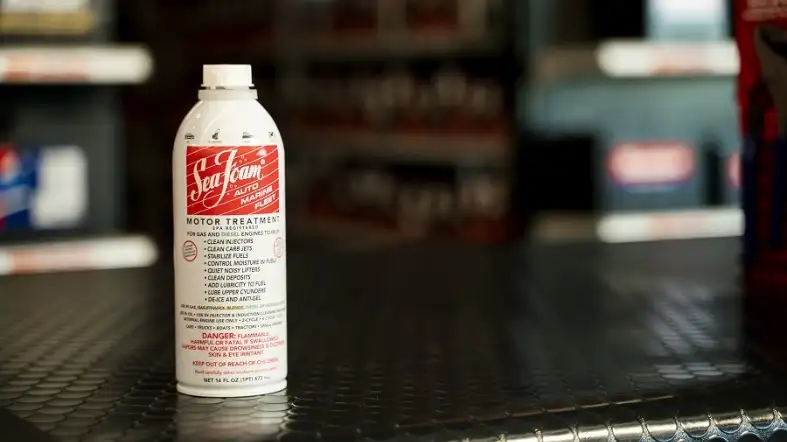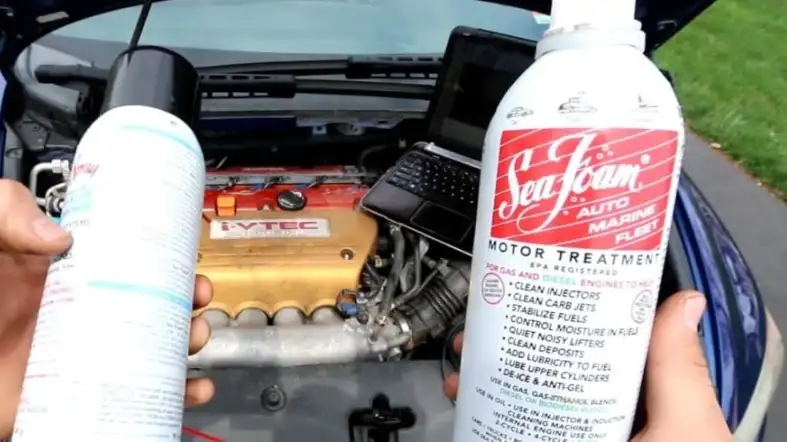Have you ever heard of Sea Foam? No, not the frothy stuff that washes up on the beach.
We’re talking about the powerful fuel additive that can clean and protect your engine like nothing else.
Using Sea Foam in your gas tank can help keep your vehicle running smoothly and even improve your gas mileage.
So, if you’re ready to give your engine the TLC it deserves, grab a can of Sea Foam and follow me as we dive into the world of fuel additives.
How To Use Seafoam In Gas?
To use seafoam in gas, add 1 ounce of seafoam per gallon of fuel. Pour it directly into your gas tank before filling it up. This can help clean your engine, reduce emissions, and improve fuel economy.

Seafoam is a popular fuel additive that can help clean your car’s engine, reduce emissions, and improve fuel efficiency.
However, using it properly is crucial to get the maximum benefits.
step-by-step guide on how to use seafoam in gas:
Step 1: Determine the Appropriate Amount of Seafoam
The first step is to determine the right amount of seafoam to use in your car. The general rule of thumb is to use one ounce of seafoam per gallon of fuel.
However, you can also use the manufacturer’s recommendations as a guide.
Be sure to read the instructions on the container carefully to avoid using too much or too little.
Step 2: Add Seafoam to the Gas Tank
Once you’ve determined the appropriate amount of seafoam, you need to add it to your gas tank.
It’s best to do this when the tank is nearly empty, so you can mix the seafoam thoroughly with the gas.
You can either pour the seafoam directly into the gas tank or use a funnel to avoid spillage.
Make sure you have enough gas to drive for a few miles after adding the seafoam to ensure it spreads throughout the fuel system.
Step 3: Drive Your Car
After adding the seafoam, you should drive your car as you would normally.
The seafoam will begin to clean the fuel system and engine as you drive, so it’s essential to take your car on a long drive to get the best results.
It’s recommended to drive for at least 30 minutes to an hour after adding seafoam to ensure it works effectively.
Step 4: Repeat the Process
If you want to see the maximum benefits of using seafoam in your gas tank, it’s recommended to repeat the process regularly.
You can add seafoam to your gas tank every 3,000 miles or as recommended by the manufacturer.
However, be careful not to overuse seafoam, as it can damage your engine if used excessively.
Note
Using seafoam in your gas tank is an effective way to clean your engine, improve fuel efficiency, and reduce emissions.
By following these four steps, you can use seafoam in your gas tank safely and effectively for maximum benefits.
Preparing to Use Seafoam in Gas

Before incorporating Seafoam into your fuel tank, it is imperative that you contemplate several pivotal elements.
These are essential for you to comprehend before commencing the process.
Step 1: Check Your Owner’s Manual
Prior to utilizing any fuel supplement, it is of utmost importance that you refer to your owner’s manual to ascertain its compatibility with your vehicle.
Specific stipulations or constraints regarding fuel additives may be applicable to certain automobiles, thus, it is advisable to verify prior to commencing the incorporation process.
If uncertain, you may seek advice from a competent mechanic or your dealership.
Step 2: Choose the Right Formula
Seafoam comes in several different formulas, including a fuel injector cleaner, a motor treatment, and a deep creep lubricant.
According to your requirements, you may opt for a specific formulation that is tailored to address certain areas of your engine.
For example, if you’re experiencing rough idling or hesitation, the fuel injector cleaner may be the best option.
If you’re looking for an all-around engine cleaner and lubricant, the motor treatment may be a better choice.
Step 3: Determine the Proper Dosage
Subsequently, once you have selected the apt formulation, you must ascertain the appropriate measurement that corresponds with your vehicle.
This may fluctuate, depending on the magnitude of your fuel tank and the gravity of your engine’s accumulation.
The manufacturer’s website or the product label usually provides the recommended measurement.
It’s important to follow the recommended dosage closely to avoid any potential damage to your engine.
Step 4: Add Seafoam to Your Gas Tank
When you’re ready to add Seafoam to your gas tank, simply pour the recommended amount into the tank before you fill up with gas.
This will ensure that the Seafoam is thoroughly mixed with the gasoline and distributed throughout your engine.
Reiteration of this process every 3,000 to 5,000 miles can be advantageous in preserving your engine’s efficiency and hygiene.
How Often Should You Use Seafoam in Gas?

However, if you’re new to using Seafoam, you may be wondering how often you should add it to your gas tank to get the best results.
Step 1: Determine Your Vehicle’s Needs
The frequency of adding Seafoam to your gas tank depends on the needs of your vehicle.
If you have an older car with a lot of miles on it, you may need to use Seafoam more frequently to keep it running smoothly.
On the other hand, if you have a newer car or one that is regularly maintained, you may only need to use Seafoam once or twice a year.
Step 2: Follow the Manufacturer’s Recommendations
Most manufacturers recommend using Seafoam once every 3,000 to 5,000 miles.
However, it’s always best to consult your vehicle’s owner’s manual for specific recommendations.
The manual should provide guidance on how often to use Seafoam and how much to add to your gas tank.
Step 3: Consider Your Driving Conditions
Your driving conditions can also play a role in how often you should use Seafoam in your gas tank.
If you frequently drive in stop-and-go traffic, dusty or dirty conditions, or have long periods of idling, you may need to use Seafoam more often.
These conditions can cause more wear and tear on your engine and can lead to deposits building up faster.
Step 4: Monitor Your Vehicle’s Performance
Ultimately, the best way to determine how often to use Seafoam is to monitor your vehicle’s performance.
If you notice a decrease in fuel efficiency, a rough idle, or other signs of engine trouble, it may be time to add Seafoam to your gas tank.
However, if your vehicle is running smoothly and you don’t notice any issues, you may not need to use Seafoam as often.
Benefits of Using Seafoam in Gas
We’ll explore the benefits of using Seafoam in your gas tank and how it can help keep your engine running smoothly.
Clean Your Engine’s Components
One of the primary benefits of using Seafoam in your gas tank is its ability to clean your engine’s components.
Over time, dirt, debris, and carbon deposits can build up in your engine, leading to reduced performance and fuel efficiency.
Seafoam’s powerful cleaning agents work to break down these deposits, allowing them to be flushed out of your engine.
This helps to restore your engine’s performance, reduce emissions, and improve fuel economy.
Lubricate Your Engine’s Parts
Another benefit of using Seafoam in your gas tank is its ability to lubricate your engine’s parts.
This can help to reduce wear and tear on your engine, leading to improved longevity and reduced maintenance costs.
Seafoam’s lubricating properties also help to reduce engine noise and vibration, making for a smoother and quieter ride.
Stabilize Your Fuel
Finally, Seafoam can help to stabilize your fuel and prevent it from breaking down over time.
This is especially important for vehicles that are stored for long periods or used infrequently.
Seafoam helps to keep your fuel fresh and prevent the buildup of harmful contaminants, ensuring that your engine runs smoothly whenever you need it.
Common Mistakes to Avoid When Using Seafoam in Gas

We will discuss some of the most common mistakes to avoid when using Seafoam in gas.
Not Following the Manufacturer’s Instructions
One of the biggest mistakes that people make when using Seafoam in gas is not following the manufacturer’s instructions.
It is important to read and understand the instructions before using the product.
Failure to do so can result in improper use, which can lead to engine damage or reduced effectiveness of the product.
To ensure optimal outcomes and evade any conceivable predicaments, it is crucial to meticulously comply with the manufacturer’s guidelines.
Adding Too Much Seafoam
Another common mistake that people make when using Seafoam in gas is adding too much of the product.
It is important to use the recommended amount of Seafoam for your vehicle’s engine. Adding too much
Seafoam can cause engine damage, reduce fuel efficiency, and even lead to engine failure.
Make sure to use the right amount of Seafoam for your vehicle’s engine size and follow the recommended guidelines to avoid any potential issues.
Using Seafoam in Old Gas
Using Seafoam in old gas is another common mistake that people make. Seafoam is designed to work best when used with fresh fuel.
Using it in old gas can reduce its effectiveness and may even cause engine damage.
Always make sure to use fresh gas when using Seafoam to ensure that it works properly and avoids any potential problems.
Not Using the Right Type of Seafoam
Finally, it is important to use the right type of Seafoam for your specific needs. Seafoam comes in different formulas, each designed for a specific purpose.
Using the wrong type of Seafoam can result in reduced effectiveness or even engine damage.
Always make sure to use the right type of Seafoam for your needs and follow the manufacturer’s instructions to ensure that it works properly.
FAQs
How Much Sea Foam Should I Use In My Gas Tank?
The recommended dosage of Sea Foam is 1 ounce per gallon of fuel.
So, for example, if you have a 15-gallon gas tank, you should pour 15 ounces of Sea Foam into the tank.
Can I Use Sea Foam In My Diesel Engine?
Yes, Sea Foam can be used in both gasoline and diesel engines.
However, the recommended dosage for diesel engines is slightly different: 1.5 ounces per gallon of fuel.
Should I Use Sea Foam Every Time I Fill Up My Gas Tank?
It’s not necessary to use Sea Foam every time you fill up your gas tank.
However, using it periodically (such as once every 3,000 miles) can help keep your engine clean and running smoothly.
Can Sea Foam Damage My Engine?
No, Sea Foam is a safe and effective fuel additive that is designed to clean and protect your engine.
It has been used by mechanics and car enthusiasts for over 75 years with great results.
Will Sea Foam Improve My Gas Mileage?
Yes, using Sea Foam can improve your gas mileage by removing harmful deposits from your engine and improving combustion efficiency. You may see an increase of up to 2 miles per gallon.
How Long Does It Take For Sea Foam To Work?
You should start to see the benefits of using Sea Foam within a few hundred miles of driving.
However, for best results, it’s recommended to use Sea Foam periodically over time.
Can I Use Sea Foam In My Motorcycle Or ATV?
Yes, Sea Foam can be used in motorcycles, ATVs, and other small engines.
The recommended dosage is 1 ounce per gallon of fuel, just like for cars and trucks.
However, if you’re not sure, it’s always best to consult your owner’s manual or a mechanic.
Conclusion
You’ve just learned all about the magic of Seafoam and how it can help keep your engine running smoothly.
Now it’s time to put that knowledge to use and start treating your gas with this fantastic fuel additive.
Remember, the key to using Seafoam is to follow the instructions on the bottle carefully.
Use the recommended amount for your engine size and follow the recommended treatment intervals.
With regular use of Seafoam, you can keep your engine clean, prevent build-up, and prolong the life of your vehicle.
So what are you waiting for? Grab yourself a bottle of Seafoam and get ready to sail the seas with a smooth-running engine.
